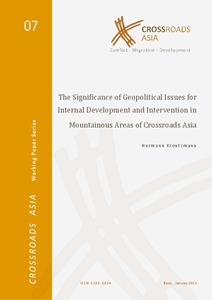The Significance of Geopolitical Issues for Internal Development and Intervention in Mountainous Areas of Crossroads Asia

The Significance of Geopolitical Issues for Internal Development and Intervention in Mountainous Areas of Crossroads Asia

| dc.contributor.author | Kreutzmann, Hermann | |
| dc.contributor.editor | Baldauf, Ingeborg | |
| dc.contributor.editor | Conermann, Stephan | |
| dc.contributor.editor | Kreutzmann, Hermann | |
| dc.contributor.editor | Nadjmabadi, Shahnaz | |
| dc.contributor.editor | Reetz, Dietrich | |
| dc.contributor.editor | Schetter, Conrad | |
| dc.contributor.editor | Sökefeld, Martin | |
| dc.contributor.editor | Hornidge, Anna-Katharina | |
| dc.date.accessioned | 2016-10-05T12:36:08Z | |
| dc.date.available | 2016-10-05T12:36:08Z | |
| dc.date.issued | 01.2013 | |
| dc.identifier.uri | https://hdl.handle.net/20.500.11811/130 | |
| dc.description.abstract | This working paper illustrates the process of territorial transformation in time and space. From the period of Silk Road networks to imperial designs for spatial control in Crossroads Asia, external interests for local and regional resources were the driving forces for superpower confrontation. The Great Game is the 19th century highpoint of confrontation leading to boundary-making and restricted trade relations. Decisions taken in faraway locations – capitals of superpowers of their time – had significant effects on the most remote corners of Crossroads Asia, from participation excluded communities and populations that were forced to adapt to changing circumstances, political affiliation, contested loyalties and power relations. The border regimes – in terms of communication, mobility and trade – highlight the effects of diplomatic negotiations, forceful encounters and manoeuvring in niches and spaces of neglect. Exchange across boundaries came to a stand-still with the commencement of the Cold War. In this paper constraining factors from geopolitics and internal developments within and between nation-states are presented in order to discuss the development gap with which we are confronted in this high mountainous and remote region of Crossroads Asia. Taking the establishment of ethnonymous Central Asian republics within the Soviet Union as a starting point, the long-lasting consequences for the now independent states of Central Asia are discussed. The concepts of autonomy and national segregation led to the configuration of republics without historical antecedents. The independent nation-states of Middle Asia are now faced with numerous border disputes, severe communication and exchange constraints and insufficient traffic infrastructures, which were originally established for a larger union and do not comply with the needs of sovereign states of smaller size. Tajikistan's border impasse with the People’s Republic of China represents a case of communication and trade gaps. Afghanistan is a case in point for external interests and shaping of a nation-state regardless of ethnic and historical considerations. The factors leading to buffer state development and the consequences resulting from imperial domination are discussed on different levels and illustrated with examples from Badakhshan. The Pashtunistan dispute led to a form of irredentism that has affected Afghan-Pakistan relations until today. Pakistan in itself devotes bitterly needed funds for rural development to border disputes, of which the Kashmir stalemate with India is the most costly. The importance of reconciliation for future mutual understanding, improved exchange relations, infrastructure development, and bi- and multi-lateral cooperation is underpinned by this scrutiny and investigation in past developments. The foundation of the Shanghai Cooperation Organisation (SCO) might be a first step leading to more reconciliation in border disputes and enhanced trust and exchange among neighbouring states. Physically feasible and recognizable is the extension of the road network linking and bridging neighbours and the region. | en |
| dc.format.extent | 35 | |
| dc.language.iso | eng | |
| dc.relation.ispartofseries | Crossroads Asia Working Paper Series ; 7 | |
| dc.rights | In Copyright | |
| dc.rights.uri | http://rightsstatements.org/vocab/InC/1.0/ | |
| dc.subject | Crossroads Asia | |
| dc.subject.ddc | 320 Politik | |
| dc.title | The Significance of Geopolitical Issues for Internal Development and Intervention in Mountainous Areas of Crossroads Asia | |
| dc.type | Arbeitspapier | |
| dc.publisher.name | Competence Network Crossroads Asia: Conflict – Migration – Development | |
| dc.publisher.location | Bonn | |
| dc.rights.accessRights | openAccess | |
| dc.relation.eissn | 2192-6034 | |
| dc.relation.url | http://crossroads-asia.de/veroeffentlichungen/working-papers.html | |
| ulbbn.pubtype | Zweitveröffentlichung |
Dateien zu dieser Ressource
Das Dokument erscheint in:
-
Crossroads Asia Working Paper Series (37)
Working Paper des Kompetenz-Netzwerks Crossroads Asia




